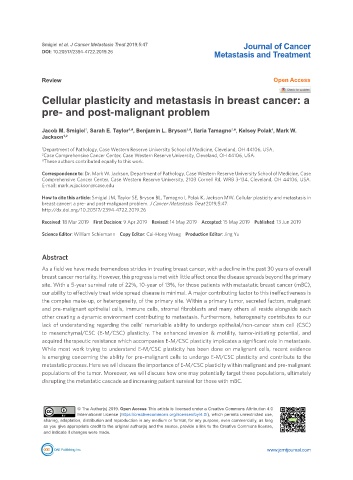Page 336 - Read Online
P. 336
Smigiel et al. J Cancer Metastasis Treat 2019;5:47 Journal of Cancer
DOI: 10.20517/2394-4722.2019.26 Metastasis and Treatment
Review Open Access
Cellular plasticity and metastasis in breast cancer: a
pre- and post-malignant problem
Jacob M. Smigiel , Sarah E. Taylor , Benjamin L. Bryson , Ilaria Tamagno , Kelsey Polak , Mark W.
1,#
1,#
1
1
1,#
Jackson 1,2
1 Department of Pathology, Case Western Reserve University School of Medicine, Cleveland, OH 44106, USA.
2 Case Comprehensive Cancer Center, Case Western Reserve University, Cleveland, OH 44106, USA.
# These authors contributed equally to this work.
Correspondence to: Dr. Mark W. Jackson, Department of Pathology, Case Western Reserve University School of Medicine, Case
Comprehensive Cancer Center, Case Western Reserve University, 2103 Cornell Rd, WRB 3-134, Cleveland, OH 44106, USA.
E-mail: mark.w.jackson@case.edu
How to cite this article: Smigiel JM, Taylor SE, Bryson BL, Tamagno I, Polak K, Jackson MW. Cellular plasticity and metastasis in
breast cancer: a pre- and post-malignant problem. J Cancer Metastasis Treat 2019;5:47.
http://dx.doi.org/10.20517/2394-4722.2019.26
Received: 18 Mar 2019 First Decision: 9 Apr 2019 Revised: 14 May 2019 Accepted: 15 May 2019 Published: 13 Jun 2019
Science Editor: William Schiemann Copy Editor: Cai-Hong Wang Production Editor: Jing Yu
Abstract
As a field we have made tremendous strides in treating breast cancer, with a decline in the past 30 years of overall
breast cancer mortality. However, this progress is met with little affect once the disease spreads beyond the primary
site. With a 5-year survival rate of 22%, 10-year of 13%, for those patients with metastatic breast cancer (mBC),
our ability to effectively treat wide spread disease is minimal. A major contributing factor to this ineffectiveness is
the complex make-up, or heterogeneity, of the primary site. Within a primary tumor, secreted factors, malignant
and pre-malignant epithelial cells, immune cells, stromal fibroblasts and many others all reside alongside each
other creating a dynamic environment contributing to metastasis. Furthermore, heterogeneity contributes to our
lack of understanding regarding the cells’ remarkable ability to undergo epithelial/non-cancer stem cell (CSC)
to mesenchymal/CSC (E-M/CSC) plasticity. The enhanced invasion & motility, tumor-initiating potential, and
acquired therapeutic resistance which accompanies E-M/CSC plasticity implicates a significant role in metastasis.
While most work trying to understand E-M/CSC plasticity has been done on malignant cells, recent evidence
is emerging concerning the ability for pre-malignant cells to undergo E-M/CSC plasticity and contribute to the
metastatic process. Here we will discuss the importance of E-M/CSC plasticity within malignant and pre-malignant
populations of the tumor. Moreover, we will discuss how one may potentially target these populations, ultimately
disrupting the metastatic cascade and increasing patient survival for those with mBC.
© The Author(s) 2019. Open Access This article is licensed under a Creative Commons Attribution 4.0
International License (https://creativecommons.org/licenses/by/4.0/), which permits unrestricted use,
sharing, adaptation, distribution and reproduction in any medium or format, for any purpose, even commercially, as long
as you give appropriate credit to the original author(s) and the source, provide a link to the Creative Commons license,
and indicate if changes were made.
www.jcmtjournal.com

